Invisalign – Danville, CA
Straighten Your Teeth Without the Metal
Whether you’re struggling to smile confidently because your teeth overlap or because there are noticeable gaps between your teeth, don’t worry – metal braces aren’t your only option. In fact, our board-certified orthodontist can straighten your teeth without any metal at all thanks to Invisalign’s innovative clear aligners! If you’re interested in learning more about this popular orthodontic treatment , you can schedule an appointment with us or read on.
Why Choose Main Street Family Dental of Danville for Invisalign?
- Board-Certified Orthodontist In-House
- State-of-the-Art Dental Technology
- Flexible Financing Available with CareCredit
How Invisalign Works
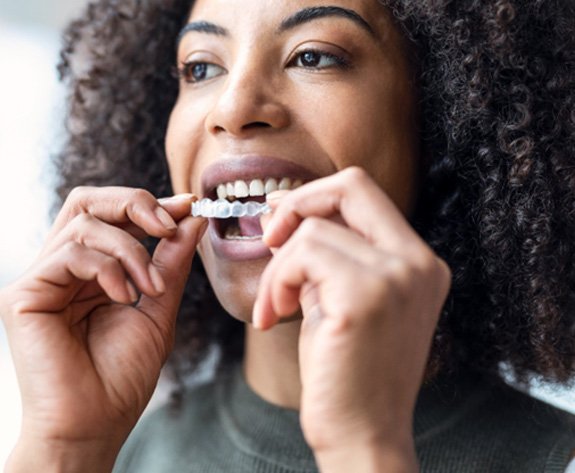
Since there aren’t any brackets and wires, you might be wondering, “How does Invisalign work?” Basically, our board-certified orthodontist will create a series of clear aligners that are designed to incrementally move your teeth closer and closer to their ideal positions. You’ll wear each tray for 22 hours a day, only taking them out to eat, drink anything other than water, and complete your oral hygiene regimen. At the end of your treatment (which on average takes 12-18 months), you’ll have the straight smile you’ve always wanted!
Who Can Invisalign Help?
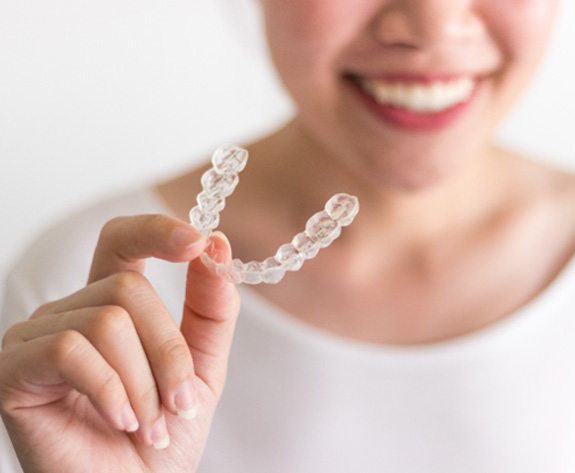
Invisalign is quite versatile. In fact, it can help patients who are struggling with crowded teeth, gapped teeth, and uneven bites! To learn a little more information about each of these orthodontic problems, give us a call to schedule your consultation or read on.
Crowded Teeth
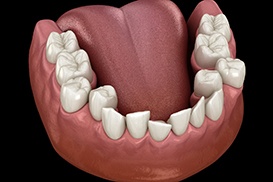
Overlapped teeth can result in numerous problems. One of the most notable is the increased risk of oral health problems, like tooth decay and gum disease. Don’t worry – we can gently guide your teeth out of their misaligned positions with a custom-made series of clear aligners, reducing the chances of cavities, improving your chewing patterns, and boosting your self-esteem.
Gaps Between Teeth
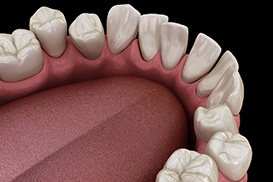
Similar to overcrowded teeth, spaced-out teeth can negatively impact the look, health, and function of your smile. Fortunately, we can use Invisalign to gradually close the gaps, improving the alignment of your teeth and bite in the process. As an added bonus, the trays are see-through, which means you’ll be able to watch it happen before your eyes (and in an average of just 12-18 months)!
Overbite
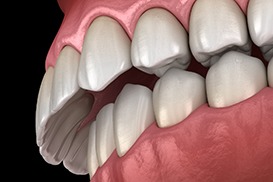
An overbite is just one example of a bite problem that can make it difficult to chew and increase your risk of premature wear. With the help of orthodontic accessories, like rubber bands, we can use Invisalign to improve the position of your teeth as well as the alignment of your bite! That way, the final result is the healthy, beautiful, and functional smile you deserve.
Underbite
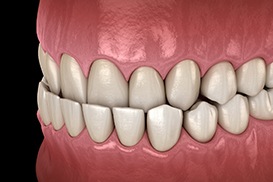
If your lower teeth sit in front of your upper ones, then you have an underbite. Even in minor cases, this bite problem can make it difficult to chew, enunciate clearly, and smile confidently. Not to mention that the unnatural position of your jaw can lead to chronic pain and TMJ dysfunction too. So, if you have an underbite, don’t wait – schedule a consultation with us so we can learn more about your dental history, the severity of your case, and, ultimately, if you’re a candidate for Invisalign.
Crossbite
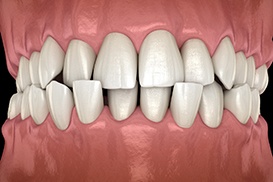
If you’ve read the above sections about overbites and underbites, and it seems like you have a mixture of the two, then you may have a crossbite. The good news is that some patients with this bite problem are candidates for Invisalign. Often, this requires the use of additional orthodontic accessories, like attachments, rubber bands, and buttons. Of course, if that’s the case, we will review all of this information with you at your consultation.
Open Bite
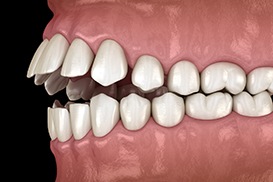
An open bite is when your teeth don’t come together evenly in the front or back. Since pressure isn’t evenly distributed, premature wear and tear is a common problem. Fortunately, Invisalign has proven to be effective in more mild cases. So, if you thought that metal braces were your only option, think again!
Benefits of Invisalign

The most obvious benefit of Invisalign is that there aren’t any metal brackets and wires – the aligners are virtually invisible. However, we want to use this section to cover some of the perks that aren’t talked about as much. With this in mind, keep reading to learn some features of clear aligner treatment that are often overlooked!
Shorter Average Treatment Timeline

Usually, treatment plans with traditional braces are 2-3 years, but there are some cases where it takes even longer. Conversely, the average Invisalign treatment plan is 12-18 months! In addition to providing you with an estimate of your teeth-straightening journey at your consultation, we will share all of our tips and tricks on how to avoid unwanted treatment plan delays, including how to meet the 20+ hour-a-day wear time.
Freedom to Eat Whatever You Want

With traditional braces, tortilla chips, popcorn, whole apples, and certain nuts and seeds are off the table. In fact, pretty much any foods that are crunchy, hard, or sticky should be avoided. Invisalign, on the other hand, doesn’t come with any dietary restrictions. The only thing you need to keep in mind is how your diet impacts your oral health. If you have a lot of attachments, it’s a good idea to exercise caution with certain foods as well.
Hassle-Free Oral Hygiene

As you can imagine, brushing and flossing your teeth with metal brackets and wires can be a bit cumbersome. In fact, many patients end up having to buy special oral hygiene products, like interproximal toothbrushes, in order to do the job properly. Don’t worry – that’s not the case with Invisalign. Since the aligners are removable, you can complete your oral hygiene regimen without any obstacles.
Quick Follow-Ups

Typically, patients with traditional braces need to come in for adjustment appointments every four weeks. Conversely, patients with Invisalign come in every 6-8 weeks. Plus, the visits are usually much quicker (about 15 minutes). Of course, there are some exceptions, like if your teeth aren’t tracking properly. If that’s the case, then we will need to figure out why that is and what changes need to be made to your treatment plan to accommodate that.
Improved Comfort

Another difference between traditional braces and Invisalign is that the latter uses a series of clear, custom-made aligners instead of metal brackets and wires. That makes the teeth-straightening process considerably more comfortable, especially since the trays are crafted from high-quality, low-profile, and smooth plastic. So, any soreness you experience will simply be from the movement of your teeth, which is a sign that the aligners are working!
Versatility

Over the last two decades, Invisalign has helped millions and millions of patients achieve their dream smiles. In fact, clear aligners have been used to address everything from overcrowded and spaced-out teeth to overbites and underbites! So, if you’re interested in Invisalign, there’s a good chance that you’re a candidate.
Understanding the Cost of Invisalign

There isn’t a flat fee, which is why you’ll have trouble pinpointing an accurate price online. If you are interested in getting an estimate, then we recommend scheduling an appointment with our Danville dental team. That way, we can assess the severity of your misalignment and determine how many trays you need. From there, we can customize your treatment plan, provide you with a price estimate, and review the financial solutions available to make the cost more affordable!
Factors That Affect the Cost of Invisalign
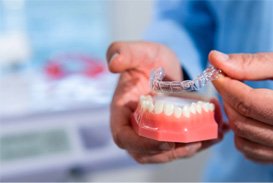
We touched on two factors that will impact the cost of Invisalign above: the severity of your misalignment and how many trays you’ll need. Of course, those aren’t the only ones. We also need to consider if we need to straighten one or both arches of your teeth as well as if any orthodontic accessories need to be added to your treatment plan, like rubber bands. It’s also possible for you to fall off-track, which may require additional costs down the line.
Invisalign vs. Smile Direct Club™: Which Costs More?
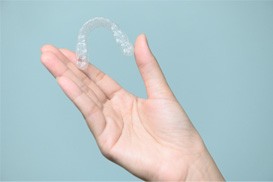
Almost always, mail-order aligner companies like Smile Direct Club™ are cheaper. That’s because they rely on DIY impressions and don’t conduct thorough evaluations. It’s also worth mentioning that they have been sued by previous patients due to worsened misalignment, and they don’t have support from professional organizations like the American Dental Association. Invisalign, on the other hand, has helped more than 12 million patients over the last two decades safely and effectively straighten their teeth!
Does Dental Insurance Cover Invisalign?
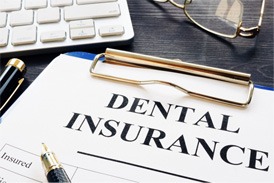
Sometimes! It’s best to take a look at the fine print on your dental plan to see if you’re a candidate. If you have a once-in-a-lifetime orthodontic benefit and Invisalign is deemed “medically necessary,” then your provider may cover a portion of the cost. As always, we’re here to help! We’re happy to welcome several of the nation’s leading providers, including Delta Dental, Aetna, BlueCross BlueShield, and Cigna. That means that we can answer any questions you have about your coverage and even handle the paperwork on your behalf, making the entire process much smoother.
Options for Making Invisalign Affordable

Currently uninsured? The good news is that there is another way to make the cost of Invisalign more affordable: flexible financing. At Main Street Family Dental of Danville, we’re proud to welcome CareCredit, which is a trusted third-party financier that has helped millions of patients over the years with their payment plans. Essentially, you just pick the one that fits best with your monthly budget – it’s that simple! As always, if you have any questions, don’t hesitate to get in touch with us so we can help.
Invisalign FAQs
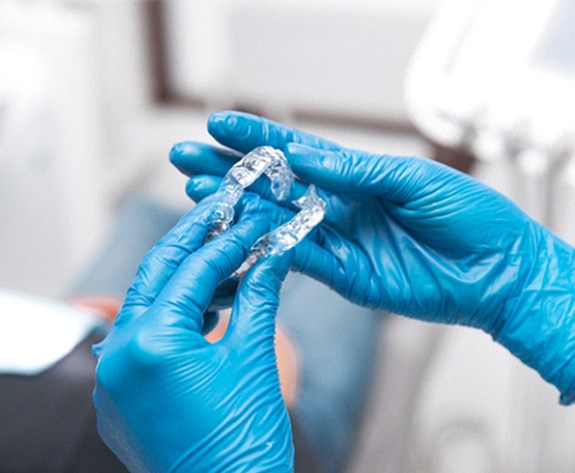
If you have questions about Invisalign, then you want answers before signing on the dotted line. Don’t worry – we’re here to help! In addition to answering any questions you have at your consultation or over the phone, you can read on to learn the answers to FAQs about clear aligner treatment in this next section.
Does Invisalign Hurt?
To be honest, every orthodontic treatment – including Invisalign – comes with some soreness as your teeth are being moved into their properly aligned positions. The good news is that the trays are smooth and comfortable, with no metal brackets or wires in sight. Plus, things like sipping on cool water, sticking to soft foods, and taking OTC pain medication (as directed) can help prevent any discomfort from arising during your teeth-straightening journey.
Is There Anything I Can’t Eat with Invisalign?
Although there aren’t any foods that are completely off-limits, there are a few we recommend avoiding. Sour gummy candies are one example because they simultaneously increase your risk of tooth decay and an attachment coming loose. We can provide more information at your appointment, but the short answer is that it’s best to stick to smile-friendly, nutrient-dense foods as much as possible (i.e., plain yogurt, cooked green beans, whole apples).
Can I Drink Coffee with Invisalign?
Yes, you can drink coffee throughout your entire Invisalign journey! Since this dark-colored beverage can stain your teeth and result in cavities, we do recommend using a straw and keeping additives like sugar to a minimum.
Important note: You need to take out your aligners before drinking coffee – no exceptions. If you don’t, then your trays can develop stubborn stains that are hard to remove.
What Happens If I Lose an Aligner?
It’s common for the first reaction to be panic. However, it’s even harder to find what you’re looking for when your mind is frazzled. That’s why we recommend taking a few deep breaths before carefully retracing your steps. In the process, look in “random” places, like the center console of your car or your laundry basket. If you can’t find them, then give us a call.
What Happens After Invisalign?
Once you’ve completed your entire series of trays, we will take your final photos and scans. Once your retainer arrives, we’ll also remove any attachments you have and make sure it fits properly. Then, we will give you instructions on when to wear it and how to take care of it.
Important note: If a few of your teeth were particularly stubborn, we may recommend wearing it around the clock for the first two or three months. After that, you should wear them each evening to prevent orthodontic relapse (the phenomenon where your teeth begin to move back to their previous, misaligned positions).
